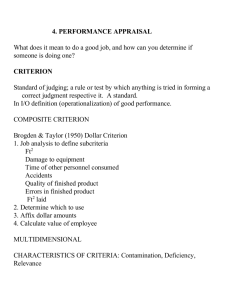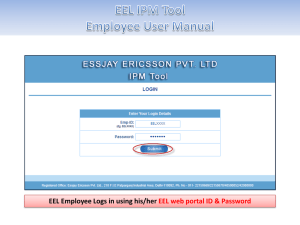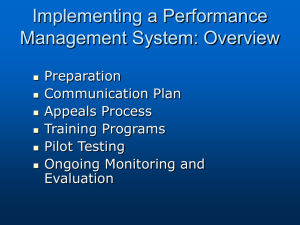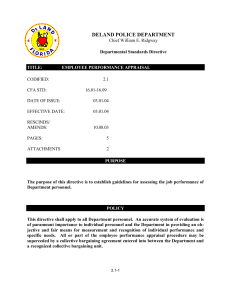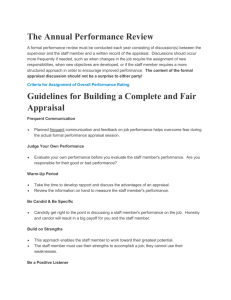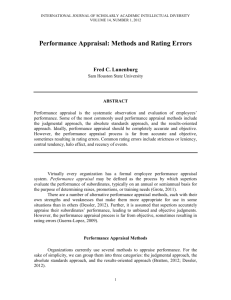Performance Appraisal Performance appraisal is the formalized
advertisement
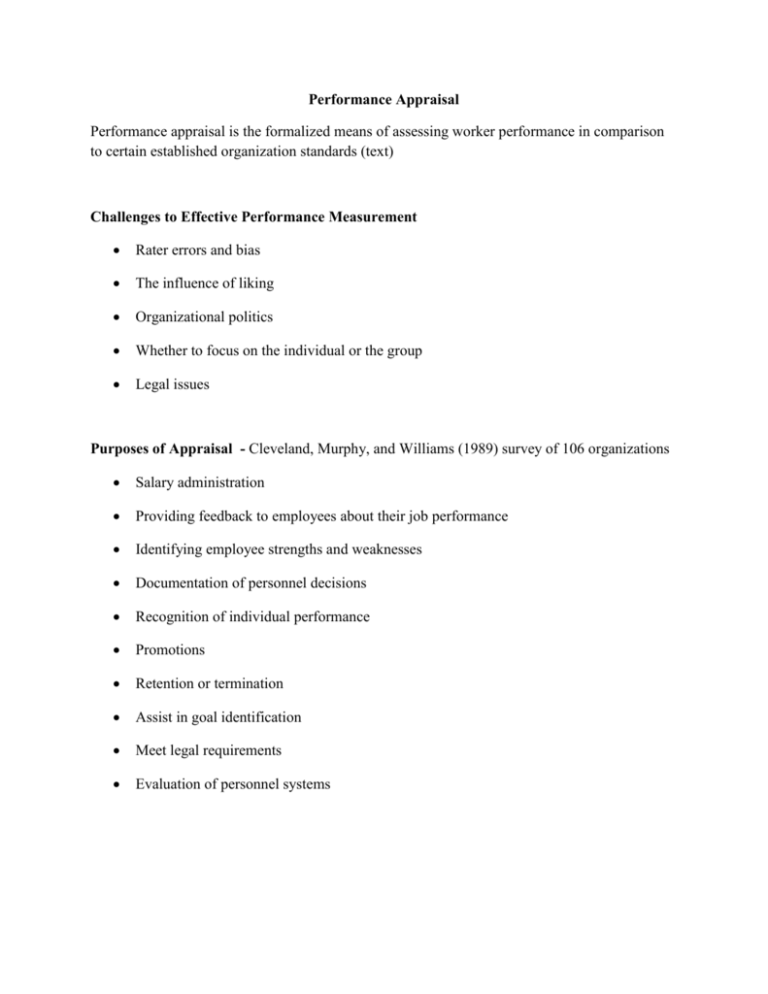
Performance Appraisal Performance appraisal is the formalized means of assessing worker performance in comparison to certain established organization standards (text) Challenges to Effective Performance Measurement Rater errors and bias The influence of liking Organizational politics Whether to focus on the individual or the group Legal issues Purposes of Appraisal - Cleveland, Murphy, and Williams (1989) survey of 106 organizations Salary administration Providing feedback to employees about their job performance Identifying employee strengths and weaknesses Documentation of personnel decisions Recognition of individual performance Promotions Retention or termination Assist in goal identification Meet legal requirements Evaluation of personnel systems Critics of Performance Appraisal Labor unions o Prefer seniority rather than assessment Employees o Prefer not to be told of deficiencies Managers o Dislike playing the role of judge Legal and Fairness Criteria (Malos,1998) Should be objective rather than subjective Should be valid and job-related or based on job analysis Should be based on behaviors rather than traits Should be within the control of the ratee Should related to specific functions, not global assessments Should be standardized and uniform Should be formally communicated to employees Should provide access to the results Should use multiple, diverse, unbiased raters Should provide a formal appeal process Who should do the performance appraisal? Immediate supervisor (most common) Peers Subordinates (upward feedback) Customers Self-appraisals (most lenient) 360-degree evaluation (multiple sources) Problem: What We Tend To Remember First impressions Recent behaviors Unusual behaviors Extreme behaviors Behavior consistent with opinion Problems with Appraisal Halo Effect or Error The halo effect occurs when the rater tends to give the same level of rating across all dimensions. The most frequent tendency is for people to give uniformly positive ratings across dimensions. Often based on liking Negative ratings is called the “Horns effect” Reducing Halo Effect Use multiple raters Rate all ratees on one dimension at a time Distribution or Constant Errors Based on the different standards used by raters Leniency errors Severity errors Central Tendency errors Can be corrected by requiring distribution of ratings according to the normal curve Leniency Errors - occurs when raters give all subordinates positive ratings The leniency is more common than severity Why? a desired to be liked and avoid hostilities a concern that it will reflect on their performance a concern that it will unfairly affect the subordinates pay Severity errors - occurs when a rater gives mainly negative or harsh evaluations Why? a rater who has high or unreasonably high standards a perception that employees who receive very positive evaluations may compete for their jobs a desire to motivate employees by giving them room for improvement Central Tendency Errors - Rating each employee in the middle of the scale A conservative strategy in which a rater attempts to avoid making mistakes by given everyone an average appraisal Several possible causes including the inability to distinguish between employees Recent‑Performance Error A rater evaluates a worker's most recent job behavior rather than behavior throughout the period since last appraisal False high rating False low rating To reduce this type of error, require more frequent performance appraisals Inadequate Information Error Supervisors rate subordinates even though they don't know enough about them to rate them fairly or accurately Train raters and allow them to decline to rate those they don't know well Similar-to-me effects - Occurs when the rater evaluates the other person on the basis of similarity of that person to the rater Physical Attractiveness Effects Research has shown that physically attractive persons receive higher ratings than those who are less attractive (Stone, Stone, & Dipboye, 1992) Personal Liking Effects The tendency for ratings to be influenced by the evaluator’s personal liking for the ratee Contrast Errors Refers to the influence that another person’s appraisal can have on someone’s appraisal Your appraisal could be lower or higher depending on who you are contrasted with. Negativity Bias Effect - The tendency to place more weight on negative information than on positive or neutral information 3 Major Approaches to Measuring Performance Criteria Objective performance and output measures Personnel or job-related data measures Judgmental and qualitative measures Objective Approaches to Performance Appraisal Output measures (Hard performance data) Quantity of outputs (# of items sold) Quality of outputs (Mistakes) Computerized performance monitoring Computers can be programmed to monitor employee's on‑the‑job activities Attitudes toward computer monitoring depend on how the data are used Found to be stressful Personnel or Job-related measures Absenteeism Rate of advancement Lateness Accidents Letters of reprimands or commendations Turnover rates Personnel or Job-related measures Easy to acquire, Archival data, usually in personnel files Tells us little about job performance or the ability of the worker Other environmental factors must be considered (economy) Subjective or Judgmental Performance Appraisal Methods Written narratives Brief essays and numerical rating procedures More prone to personal bias Comparison Methods Rating Methods Employee Comparison Methods Ranking Paired Comparison Forced Distribution Ranking Technique Supervisors list the workers in order from highest to lowest Simple to do Difficult when there are many employees to evaluate Provides less evaluative data than rating Doesn't allow for listing of similarities Does not show size of differences in performance between employees Implies that lowest-ranked employees are unsatisfactory performers. Paired‑Comparison Technique Compares the performance of each worker with that of every other person in the group Advantage –Accurate judgmental process is simple Disadvantage -many comparisons when dealing with a large number of employees Forced Distribution Technique It is a type of ranking in which you sort employees into categories using predetermined quotas. The distribution is approximately a normal curve. More common is a negatively skewed Drawbacks Resistance by managers to placing individuals in the lowest or highest groups. Assumes a normal distribution of performance. Is not readily applicable to small groups of employees. Ratings of Performance Graphic Rating Scales Behavior-Based Methods Graphic Rating Scale Graphic Rating Methods Supervisors indicate how or to what degree a worker possesses a relevant job characteristic Most frequently used technique Behavior Based Methods Behavioral Rating Approach Assesses employees’ behaviors instead of other characteristics Consists of a series of scales created by: Identifying important job dimensions Creating statements describing a range of desired and undesirable behaviors (anchors) Types of behavioral scales Behaviorally anchored rating scales (BARS) Behavioral observation scales (BOS) Behavioral expectation scales (BES) Developing Behavior based Rating forms 1. Job analysis to define job dimensions 2. Develop descriptions of effective and ineffective job performance from critical incidents 3. Have knowledgeable judges place descriptions into job dimensions 4. Have knowledgeable judges rate the effectiveness of the descriptions Behavioral Anchored Rating Scale (BARS) The first behavioral focused or based rating scale (Smith & Kendall, 1963) Developed for many different jobs it includes set of scales- one scale for each major job dimensions or broad class of duties Placed on each scale are sets of anchors of statements illustrating worker behavior on a particular job dimensions The BARS can use the same dimensions as a graphic rating form The Performance Appraisal Process A good performance appraisal consists of two parts: Performance assessment. Performance feedback. Conclusions Performance evaluation is an important issue both for companies and for workers With careful design and appropriate use, performance evaluations can support productivity and fair allocation of rewards Industrial-organizational psychologists specialize in making sure that performance evaluations are designed correctly

